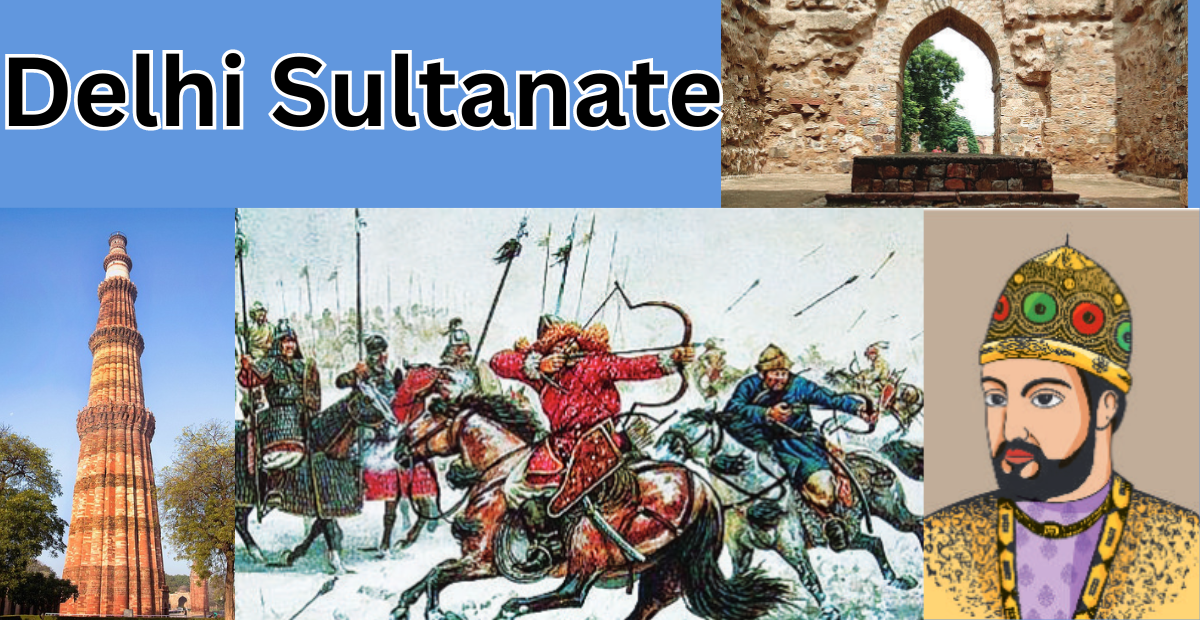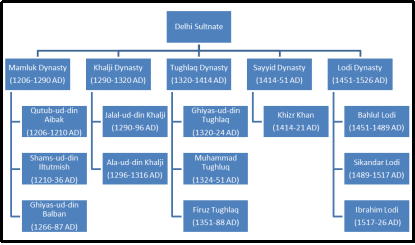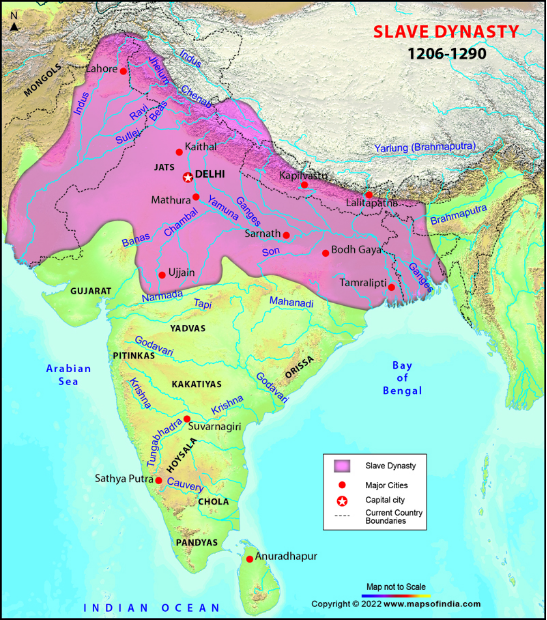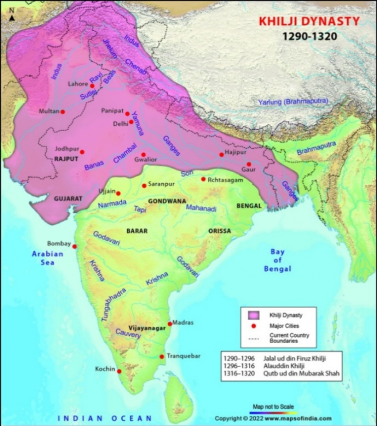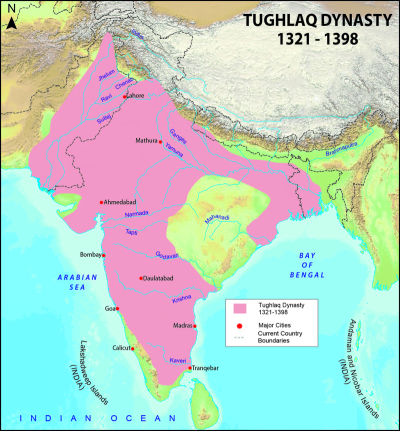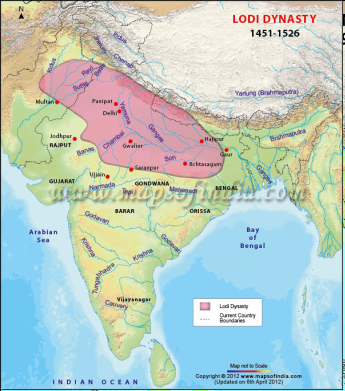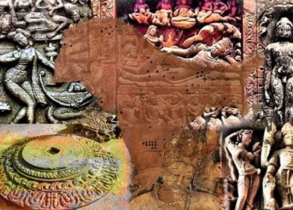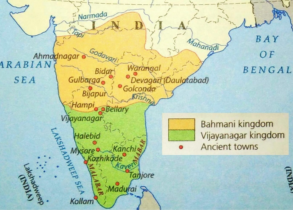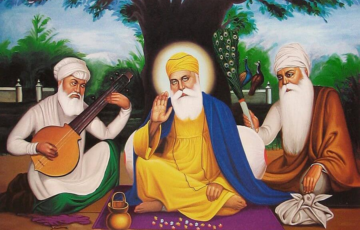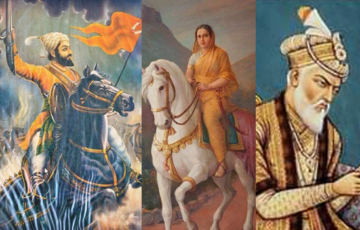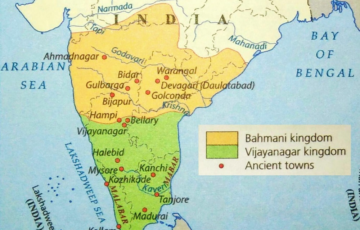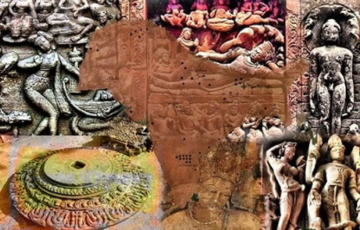DELHI SULTANATE
The Delhi Sultanate, an Islamic empire centered in Delhi, endured for 320 years and wielded authority over significant swathes of South Asia. Established after the Ghurid dynasty’s conquest of the subcontinent, it saw succession from five distinct dynasties: the Mamluk dynasty (1206–1290), the Khalji dynasty (1290 – 1320), the Tughlaq dynasty (1320–1414), the Sayyid dynasty (1414–1451), and the Lodi dynasty (1451-1526). Its dominion encompassed extensive territories comprising present-day India, Pakistan, and Bangladesh, along with portions of southern Nepal.
Mamluk Dynasty (Slave) (1206 – 1287)
The Mamluk dynasty, also known as the Slave dynasty, marked the inception of the Delhi Sultanate. Qutb ud-Din Aibak, a Turkic Mamluk slave-general hailing from Central Asia under the Ghurid Empire, established the Mamluk dynasty in Northern India. From 1206 to 1290, the Mamluk dynasty held sway over the Delhi Sultanate. Prior to ascending the throne, Qutb al-Din Aibak served as a governor for the Ghurid dynasty from 1192 to 1206, during which he orchestrated military campaigns into the Gangetic plain, thereby extending his dominion over newly acquired territories.
Background
- The term “Mamluk” derives from Arabic, meaning “owned,” and denotes a prominent military aristocracy that emerged within the Abbasid Caliphate’s Islamic Empireduring the 9th century AD.
- Despite their status as slaves, Mamluks were highly valued by their masters, owing to their exceptional military prowess and loyalty.
- The Mamluk Dynasty of the Delhi Sultanate featured three notable rulers: Qutb-ud-din Aibak, Shams-ud-din Iltutmish, and Ghiyas-ud-din Balban.
- Qutb-ud-din Aibak, the inaugural ruler of the Slave dynasty, held power from 1206 to 1210.
- Following him, Iltumish assumed leadership and governed from 1211 to 1236, guiding the Slave dynasty to consolidate its influence and establish itself as a significant kingdom.
- Ghiyasuddin Balban, the last effective emperor of the Slave dynasty, ruled from 1266 to 1286, focusing keenly on governance and military affairs.
- Under Balban’s rule, the kingdom prioritized military training and the development of weaponry, enhancing its military capabilities and fortifying its position within the region.
Important Rulers
Qutb ud-Din Aibak(1206-1210 AD):
- Qutb ud-Din Aibak, born around 1150 CE, served as a distinguished general in the Ghurid army operating in India.
- Following the Ghurid triumph in theSecond Battle of Tarain in 1192, Muhammad Ghori entrusted Aibak with the command of his Indian domains.
- Aibak significantly augmented Ghurid influence in northern India through the conquest and plunder of various kingdoms, including those of theChahamana, Gahadavala, Chaulukya, Chandela, among others.
- Upon Ghori’s demise in 1206, Aibak engaged in a struggle for control over Ghurid territories in northwestern India against Taj al-Din Yildiz, another former slave-general.
- Aibak encountered numerous challenges, including revolts by Rajputs and other indigenous chiefs, which he managed to quell through a combination of diplomatic overtures and displays of military might.
- His succession was marked by Aram Shah and later by his son-in-law Iltutmish, who solidified the loosely held Ghurid territories into the formidable Delhi Sultanate.
- Notably, Aibak’s legacy is immortalized through architectural marvels such as the Delhi Qutb Minar and theAjmer Adhai Din Ka Jhonpra.
Achievements of Qutb ud-Din Aibak:
- Qutb-ud-din Aibak played a pivotal role in the conquests of northern India, aiding Ghori in consolidating his influence in the region.
- Aibak chose to maintain his autonomy from Central Asian policies and focused on bolstering his authority in Delhi and Lahore.
- He strategically allied with Turkish nobles by arranging marriages between his family members and theirs, thus securing their allegiance.
- Internally, Aibak faced challenges such as the deposition of Ali Mardan Khan, ruler of Bengal and Bihar, which he resolved by diplomatic and military means.
- Rumi Khan, acting on Aibak’s behalf, subdued the rebellious Khalji nobles in Bengal and reinstated Ali Mardan Khan as the governor under Delhi’s suzerainty.
- Aibak’s expansionist endeavors were curtailed due to the need to defend his realm, particularly against threats from northwest states and Bengal, leading him to spend more time in Lahore than Delhi.
Religion of Qutb ud-Din Aibak:
- A devout Muslim, Aibak was known for his enforcement of Islamic principles, including the abolition of idolatry and conversion of Hindu temples into mosques.
- Under his reign, numerous Hindu temples across cities like Meerut, Banaras, and Kalinjar were repurposed as mosques, with Banaras alone witnessing the conversion of around a thousand temples.
- Architectural structures like the Qutb Minar complex in Delhi and the Adhai Din Ka Jhonpra in Ajmer utilized materials from demolished Hindu temples.
- Despite his religious policies, Aibak’s army integrated Hindu soldiers, and Hindu chiefs accompanied him on military expeditions, showcasing a degree of religious tolerance in his governance.
Death of Qutb ud-Din Aibak:
- Qutb-ud-din Aibak met his demise in a tragic accident while playing polo in 1210, sustaining fatal injuries from a fall off his horse.
- He was laid to rest near the Anarkali bazaarin Lahore, and his successor, Aram Shah, ruled briefly for eight months before being succeeded by Iltutmish.
- Aibak’s tomb, located in Anarkali bazaar, Lahore, was reconstructed during the 1970s by Pakistan’s Department of Archaeology and Museums, preserving Sultanate-era architectural styles.
Iltutmish (1211 – 1236 AD)
- Iltutmish, born a member of the Turkish Ilbari tribe, entered the service of the Sultan of Delhi, Qutb ud-Din Aibak, after being purchased at a significant price.
- Despite his origins as a slave, Iltutmish received a comprehensive education, acquainting himself with the intricacies of the Islamic world during his formative years of hardship.
- Within a decade, he ascended to the esteemed positions ofamir-e-shikar and son-in-law to his master, showcasing his capabilities and gaining trust.
- He swiftly rose through the ranks, eventually becoming the governor of the iqtas of Gwalior and Baran (Bulandshahar) by 1206.
- Recognized as one of Aibak’s most reliable lieutenants, Iltutmish commanded Badaun, solidifying his status within the Ghurid administration.
Achievements and Expansion of Empire:
- Iltutmish’s reign was marked by significant military victories and territorial expansion, including the defeat of Taj al-Din Yildiz, a former slave who contested Ghurid succession.
- His triumph over Yildiz at Tarain in 1216 consolidated the independence of the Delhi Sultanate.
- Another formidable opponent, Qabacha, was subdued through concerted military campaigns, leading to the annexation of Sind and Multan into the Sultanate.
- Iltutmish successfully reasserted Delhi’s authority over Bengal, quelling rebellions and annexing the region after successive expeditions.
- Additionally, he re-annexed numerous states that had declared independence after Aibak’s death, such as Ranthambore, Gwalior, Ajmer, Bayana, Jalor, Mander Kalinjar, and Thangir.
- His conquests culminated in the expansion of the Turkish empire in India to its former extent during Aibak’s reign.
Architecture During Iltutmish’s Reign:
- Iltutmish was a notable patron of art and architecture, overseeing the construction of various mosques, waterworks, and civic amenities in Delhi.
- He completed the Qutb Minar, initiated by Qutb al-Din Aibak, and erected the Hauz-i-Shamsi reservoir and accompanying madrasa.
- Several khanqah (monasteries) and dargahs (graveyards) were constructed under his patronage, including Hamid ud-din’s Khanaqa and theGandhak ki Baoli.
- The Sultan Ghari funerary monument, commemorating his eldest son Nasiruddin, was erected in 1231 during his reign.
Death of Iltutmish:
- Constant military engagements took a toll on Iltutmish’s health, leading to illness in 1235 AD during an expedition against Bayana.
- Despite efforts to recuperate in Delhi, he succumbed to his illness in 1236 after a year of struggle, leaving behind a legacy of twenty-five years of glorious rule.
- He was interred in the Qutub complex in Mehrauli, marking the end of an era for the Delhi Sultanate.
Razia Sultan (1236-1240 AD)
- Razia was born to Turkan Khatun, the chief wife of Delhi Sultan Shamsuddin Iltutmish, making her most likely his eldest daughter.
- She was known by various names such as Raziyyat-ud-din, Razia Begum, or Sultana Razia, and she holds the distinction of being the first and only woman to ascend the throne of Delhi among both Muslims and Hindus.
- Razia’s upbringing under her father’s tutelage honed her skills in archery and horsemanship, traits that she showcased from a young age by accompanying him on military campaigns.
Accession to Throne:
- Razia’s exceptional abilities and sincerity distinguished her from her brothers, who were more interested in luxuries and privileges.
- Defying established Muslim conventions, Iltutmish designated Razia as his heir apparent, a groundbreaking decision that marked her as the first female Sultan in history.
- Upon Iltutmish’s demise in April 1236, despite his prior declaration, the Muslim nobility opposed Razia’s rule, leading to the appointment of her brother Rukn-ud-din Firuz as Sultan.
- Ruknuddin’s reign proved disastrous, with his mother, Shah Turkaan, effectively governing while he indulged in royal extravagances.
- Razia’s opportunity arose when bothRuknuddin and Shah Turkaan were assassinated within six months of his reign, paving the way for her ascension to the throne on November 10, 1236, under the title Jalâlat-ud-Dîn Raziyâ.
Reign of Razia Sultana:
- Razia’s reign was marked by efforts to establish law and order, promote trade, improve infrastructure, and enhance administrative efficiency.
- She personally appointed numerous officials, managed state affairs through open durbar sessions, and fostered intellectual pursuits by establishing schools, research centers, and libraries.
- Departing from traditional gender norms, Razia eschewed veiling and adopted gender-neutral attire akin to male rulers before her.
- She patronized scholars, artists, and craftsmen, contributing to the advancement of culture and craftsmanship during her rule.
Decline of Razia Sultana:
- Razia’s reign faced challenges from various quarters, leading to her eventual deposition by rebellious governors.
- Notably, the death of Malik Ikhtiar-ud-Altunia, governor of Bhatinda, marked a significant setback for Razia.
- In an attempt to regain control, Razia marched against Altunia with Jamal-ud-Din Yaqut, but they faced resistance, leading to Yaqut’s death and Razia’s imprisonment.
- Forced into marriage with Altunia, Razia’s subsequent attempts to reclaim her throne ended in defeat near Kaithal, Haryana, resulting in her and Altunia’s demise, thus concluding her four-year reign as Delhi’s first and only female ruler.
Ghiyas ud din Balban (1266 – 1287 AD)
- Balban, akin to his master Iltutmish, hailed from a Turkish lineage, although his early life was marred by adversity.
- Abducted by Mongols in his youth, he was later sold to Khwaja Jamal-ud-din, a slave trader, before being acquired by Iltutmish in Delhi.
- Recognizing Balban’s intellect and prowess, Iltutmish integrated him into the renowned army of the forty slaves during his tenure in Delhi.
- Balban’s rise continued under the reign of Raziya Sultana, where he attained the position ofAmir-i-Shikar, or Lord of the Hunt.
Ascension to Throne:
- Initially supportive of Raziya, Balban later aligned with nobles to depose her, leading to her removal from the throne.
- Subsequently, under Sultan Bahram Shah’s reign, he proved himself as a formidable warrior, resisting Mongol invasions and playing a pivotal role in the political landscape.
- Following the deposition of Sultan Masud and the ascent of Nasir-ud-din Mahmud, Balban’s stature grew,culminating in his appointment as Principal Adviser and marriage to the Sultan’s daughter.
- Recognizing Balban’s invaluable contributions, Sultan Nasir-ud-din bestowed upon him the titles of Ulugh Khan and Naib-i-mamlikat, positioning him as the Deputy Sultan.
Reign of Ghiyas ud din Balban
Re-organisation of Army:
Balban instituted significant reforms in the military, bolstering its strength and efficiency.
Under the leadership of Imad-ul-Mulk as Diwan-i-Ariz, the army gained autonomy from financial oversight, contributing to its enhanced effectiveness in suppressing internal dissent and repelling external threats.
Clearance of Mewatis:
Balban quelled the menacing influence of the Mewatis on Delhi’s outskirts, orchestrating a ruthless campaign that resulted in the clearing of forests and the death of thousands.
Battle with Bengal:
The challenge posed by Bengal’s rulers necessitated Balban’s intervention, leading to the defeat and execution of Tugril Khan, followed by the appointment of Balban’s son Bugara Khan to oversee Bengal’s affairs.
Mongol Invasions:
Mongol incursions along the western frontier prompted Balban to fortify defenses, albeit with limited success.
Despite his efforts, Mongol raids persisted, prompting Balban to divide the border territories between his sons, Muhammad Khan and Bughra Khan, although the former’s demise dealt a significant blow to Balban’s resolve.
Death of Ghiyas ud din Balban:
- Balban’s health declined significantly following the death of his beloved son, Prince Muhammad, who was his favored heir.
- With age catching up to him, Balban realized the end was near and designated his grandson, Kai Khusrav, as his successor.
- He passed away at the age of eighty in 1287.
Legacy of Ghiyas ud din Balban:
- Balban was the first ruler to fully comprehend and implement the duties and responsibilities of a Sultan of Delhi, earning a reputation as one of India’s most formidable monarchs.
- He introduced Persian court customs such as Sijda (Zaminbosi) and Paibosi to India, where subjects would kneel and kiss the ground or the Sultan’s feet to greet him.
- Balban advanced the Iranian Theory of Divine Rights, asserting that the Sultan acted as God’s representative on Earth.
- He curbed the influence of the“Corp of Forty, a powerful slave group who were potential heirs to Iltutmish’s throne.
- Balban successfully defeated the Chihalagani, a formidable group of elders considered heirs to Iltutmish.
- He organized and strengthened the military to confront Mongol threats by abolishing the Naik office and establishing the Diwan-i-arz, a new military affairs agency led by the Ariz-i-Mumalik.
- Balban prioritized education, providing opportunities and facilities for educated individuals from Central Asia, fostering cultural and intellectual growth during his reign.
- Under his patronage, renowned Persian poets such as Amir Khusru and Amir Hosan flourished, contributing to the literary and cultural landscape of the era.
Administration of Mamluk Dynasty:
- Inherited from the Ayyubid kingdom, the administrative system of the Mamluk dynasty remained largely unchanged.
- The sultans, products of the military hierarchy, held supreme authority, issuing and enforcing legal orders, declaring war, and levying taxes for military campaigns.
- They oversaw the equitable distribution of food supplies and administered justice, investigating and punishing alleged criminals.
- While the sons of Mamluks could enter the military hierarchy, they rarely served in the military themselves.
- The Mamluk dynasty adhered to the Iqta System, introduced during the time of Iltutmish, where land grants replaced cash and food payments to soldiers.
- Governance of iqtaaswas entrusted to governors known as Nazim, Iqtadar, Muqta, or Vali, appointed based on qualifications by the Sultan.
- Imperial officers like Saahib-i-diwan or Khawaja sometimes supervised the iqtadar’s activities.
- Iqtaas were transferable administrative divisions, not implying land ownership.
- The Mamluk army comprised three components: the Royal Mamluk, the emir soldiers, and the halqa (non-Mamluk soldiers).
- The Royal Mamluks, under the Sultan’s direct command, served as his personal guard.
- Emirs led their own corps of soldiers, functioning akin to private armies, while the halqa, lower in rank, operated under the Sultan’s direct authority.
- With the decline in non-Mamluk soldier recruitment, halqa regiments began to disintegrate in the 14th century.
- The Mamluks standardized the army, simplifying the distribution of iqtaat to provide military unity.
- A revised iqta distribution system tied an emir’s rank to the size of his iqta, enhancing military organization.
- Ayyubid offices like ustadar, hajib, emir jandar, and khazindarpersisted, alongside new positions such as dawadar, emir akhur, ruus al-nawab, and emir majlis.
Decline of the Mamluk Dynasty:
- Muiz-ud-din Muhammad Qaiqabad, the final sultan of the Slave dynasty and grandson of Balban, reigned from 1287 to 1290, ascending to the throne at just eighteen years old.
- His wazir held significant influence over him, leading to neglect of state affairs and disorganization within the government.
- Qaiqabad’s youth and inexperience contributed to his inability to effectively govern, exacerbating the decline of the dynasty.
- After four years, he suffered a paralytic stroke and was later assassinated by a Khalji chief in 1290, further destabilizing the regime.
- Mongol invasions inflicted regular damage on the Mamluk dynasty, weakening its hold on power.
- Internal strife among members of the Mamluk dynasty also undermined the sultanate’s long-term stability, leading to divisions and conflicts.
- Many rulers lacked the strength and leadership necessary to sustain the kingdom over extended periods, hastening the decline.
- With the death of Qaiqabad, the Slave dynasty came to an end, paving the way for the succession of the Khilji dynasty.
| Important facts
● Qutbuddin Aybak earned the title “Lakh Baksh” for his generosity and rule in India. ● Capital During Reign of Iltutmish: Delhi was the capital during Iltutmish’s reign. ● Iltutmish moved the capital from Lahore to Delhi. ● Iltutmish received investiture from the Khalifa, becoming the first legally independent Sultan. ● “Slave of a Slave”: Iltutmish earned this title due to his lineage and succession within the Slave Dynasty. ● Raziyya Sultan, the only woman to occupy the throne of Delhi. ● Iltutmish ruled during the same period as Genghis Khan. ● Mongols invaded India during Iltutmish’s reign. ● Genghis Khan’s original name was Temuchin. ● Malik Jani was appointed as the first Subedar of Bihar. ● Turkish nobles, led by Malik Altunia, revolted against Raziyya Begum. ● Balban was the first to formulate the theory of kingship similar to the divine right of kings. ● Balban is known for adopting the “blood and iron” policy. ● Balban consolidated power and centralized authority primarily to defend against Mongol invasions. ● Balban assumed the grand title of “Zil-e-Ilahi” after consolidating his power. ● Balban introduced the Persian festival Navroz in India. ● Sultan Who Called Himself “Helper of a Caliph”: Balban referred to himself as the “Helper of a Caliph” in an inscription at Garhmukteshwar Mosque. |
KHILJI DYNASTY (1290 AD – 1320 AD)
The Khaljis, of mixed Turkish-Afghan origin, migrated to India during the Ghurid invasion and sought opportunities in Bengal, Bihar, and the northwest to face the Mongol threat.
Rise to Power:
Jalaluddin Khalji (1290-1296 AD)
Background:
Amidst the ineptitude of Balban’s successor and intrigue among the nobles, Malik Jalal-ud-din Khalji, a commander in the army, seized power in 1290, establishing the Khalji dynasty.
Administrative Reforms:
Jalaluddin Khalji broadened the spectrum of high offices, breaking the Turkish monopoly.
He adopted a more tolerant stance towards Hindus, acknowledging India’s Hindu majority.
Military Achievements:
Successfully repelled a Mongol invasion led by Hulagu’s grandson in 1292.
His nephew and son-in-law, Alauddin Khalji, played a significant role in the conquests during his reign.
Death:
Jalaluddin Khalji was assassinated by his nephew Alauddin Khalji, who subsequently assumed the throne.
Alauddin Khalji (1296-1316 AD)
Background:
Unlike his predecessor, Alauddin Khalji was known for his intolerance and authoritarian rule, adopting the title Sikander-i-Azam.
Administrative Reforms:
- Centralized revenue collection from farmers, bypassing traditional village headmen.
- Levied taxes primarily on the wealthy, equalizing the burden on the poor.
- Stripped traditional village officials of privileges and subjected them to additional taxes.
- Established a postal system and spy service to enhance communication and surveillance.
- Punished nobles tempted by bribery and even disciplined rebellious family members, asserting,“Kingship knows no kinship.“
- Prohibited the consumption of wines and intoxicants and banned gambling.
Military Campaigns:
- Alauddin Khalji successfully defended Delhi against the Mongol invasion led by Targhi, who besieged the city.
- Conquests of Ranthambore (1301), Chittor (1303), and Malwa (1305).
- Siege of Devagiri in 1307, led by Malik Kafur, and subsequent looting of the Somnath temple in 1314.
- Malik Kafur’s southward journey resulted in the defeat of the Kakatiya ruler of Warangal in 1309.
- Hoysala rulersurrendered treasures in 1310.
- Plundering of temple cities likeChidambaram, Srirangam, and Madurai.
- Establishment of a Muslim state in Madurai following the decline of the Pandya kingdom, subordinate to the Delhi Sultanate.
Military Reforms:
- Introduction of the Chehra (description of soldiers) and Dagh (branding of horses) system.
- Payment of soldiers in cash rather than shares of booty.
- Alauddin Khalji maintained the largest standing army among all Delhi rulers.
Market Reforms:
- Establishment of royal granaries to store grains, mitigating famines and controlling prices.
- Implementation of price controls on essential commodities to support the army on modest pay.
- Surveillance and enforcement against black-marketing and hoarding through an extensive intelligence network.
- Shahna-i-mandiwas responsible for daily reports on market prices.
- Creation of Diwan-i-Riyasat to regulate markets and prices.
- Establishment of separate bazaars for different commodities and maintenance of a registry of traders to ensure compliance with regulations.
Taxation System:
Kharaj – Agriculture Tax:
- Peasants were required to paykharaj, an agriculture tax amounting to approximately 50% of their produce.
- A specific officer known as Mustakharaj was appointed to collect this tax.
Biswa Measurement:
- Biswa, equivalent to1/20 of a bigha, was used for measuring cultivable land and assessing its productivity.
Payment Methods:
- Land tax was typically collected in cash, compelling peasants to engage in the money market.
- In the Doab region, taxes were collected on grain to prepare for future scarcity.
Additional Taxes:
- Alauddin Khalji introduced two additional taxes on peasants:charai (for grazing) and garhi (on dwellings).
- He abolished the village headman’s cess known as Kismati-Khuti.
Art and Architecture:
- Alauddin supported renowned poets of his era, including Amir Khusrau and Mir Hasan Dehlvi.
- Amir Khusrau was honored with the title ofTutii-Hind (Parrot of India).
- The conquests undertaken by Alauddin are vividly described in Amir Khusrau’s work Khazain-ul-Futuh.
- Alai Darwaza (1311): Constructed as the southern gateway of the Quwwat-ul-Islam Mosque in the Qutb complex, Mehrauli, Delhi.
- Siri Fort (1303): Located north of the Qutub complex.
- Mosque Jamait Khanm: Built within the enclosure of Nizam-ud-din Aulia’s shrine.
Death and Succession:
After Alauddin’s death in 1316, the Khilji dynasty gradually declined, leading to the usurpation of the throne by Ghazi Malik under the title Ghiyasuddin Tughlaq.
| Important Facts
● Alauddin Khalji declared himself fully independent from the rules of Shariat upon attaining kingship, as noted by Ziyauddin Barani. ● Alauddin Khalji desired to introduce a new religion but abandoned the idea due to opposition from Ulemas. ● Alauddin Khalji assumed the title of Alexander the Great. ● Zafar Khan, a prominent army commander of Alauddin Khalji, died fighting against Mongols. ● Padmini, associated with Ala-ud-Din’s conquest of Chittor, was the wife of Rana Ratan Singh. ● Ramachandra Dev was the ruler of Devagiri during Alauddin Khalji’s invasion. ● Alauddin Khalji’s army was defeated by the Kakatiya rulers at Warangal in 1303. ● Alauddin Khalji raised the land revenue to one-half of the produce. ● Alauddin Khalji enforced a strict price control system during his reign. ● Alauddin Khalji introduced the market control system. ● Alauddin Khalji started the Public Distribution System. ● Alauddin Khalji was the first to charge ‘Ghari’ or house-tax. ● The boundary between the Delhi Sultanate and the Mongols during Alauddin Khalji’s reign was the Ravi river. ● Mubarak Khilji declared himself as “Khalifa” among the rulers of the Delhi Sultanate. |
TUGHLAQ DYNASTY (1320 AD – 1413 AD)
Origin of Tughlaq Dynasty:
Turkish Origin: The Tughlaq Dynasty originated from Turkish roots, with the family adhering to the Muslim faith.
- Ascension of Ghazi Tughlaq: In 1321, Ghazi Tughlaq ascended to the throne and assumed the title Ghiyasuddin Tughlaq.
- Strong Allies:The Tughlaqs maintained their reign for an extended period due to robust alliances with Turks, Afghans, and South Asian Muslim warriors.
- Founder of the Dynasty: Ghiyasuddin Tughlaq laid the foundation of the Tughlaq dynasty in India.
- Characterized by Turmoil:The Tughlaq Dynasty was marked by a tumultuous period of torture, cruelty, and frequent rebellions.
- Territorial Disintegration:The dynasty’s territorial integrity rapidly declined after 1335 AD, largely due to internal strife and external pressures.
- Peak Period: Between 1330 and 1335 AD, the Tughlaq Dynasty reached its zenith, notably during a military campaign led by Muhammad Bin Tughlaq.
Ghiyasuddin Tughlaq (1320-1325 AD)
- Qarauna Tribe Origin:Ghiyasuddin Tughlaq hailed from the Qarauna tribe of Turks and laid the foundation of the Tughlaq dynasty.
- Defender Against Mongols: Prior to ascending to the throne, he played a pivotal role in defending the Sultanate from Mongol invasions and served as Alauddin’s Muqta in Dipalpur, Pakistan.
Conquest:
- Deccan Control:Dispatched expeditions, led by his son Mohammad Bin Tughlaq, against the Kakatiya ruler in Warangal to strengthen Sultanate control in the Deccan.
- Annexation of Bengal:Personally led a successful campaign in 1324 to annex eastern and southern Bengal, further expanding the Sultanate’s domain.
Administration:
- Reconciliation with Nobles:Adopted a policy of reconciliation with the nobility to maintain stability within the Sultanate.
- Canal Construction: Pioneered canal construction, marking the Sultanate’s first foray into irrigation infrastructure.
- Peasant Relief Measures:Implemented relief measures to alleviate the burden on peasants and village headmen, such as exemptions from additional levies and taxes on cattle.
Architecture:
- Tughlakabad Fort: Constructed the iconic Tughlakabad Fort in Delhi in 1321, showcasing his architectural prowess and military foresight.
- “Tughlaq Nama” by Amir Khusrau: Amir Khusrau’s renowned work provides a biography of Ghiyasuddin Tughlaq, along with insights into other rulers of the Tughlaq dynasty.
Death:
- Succession:Upon his demise, his son Ulugh Khan, also known as Mohammad Bin Tughlaq, succeeded him to the throne, continuing the Tughlaq legacy.
Mohammad Bin Tughlaq (1325-1351 AD)
His reign marked a pivotal period for the Delhi Sultanate, representing both its zenith and the beginning of its decline. Notably, the Moroccan traveler Ibn-Battuta served as his envoy to China, illustrating the Sultanate’s diplomatic reach.
Administration:
- Reversal of Policies:He reversed Alauddin Khalji’s policies aimed at reducing the influence of village headmen (khuts and muqaddams), seeking to ensure a larger portion of land revenue for the state.
- Revenue Management: Although maintaining the state’s share of revenue at 50%, he set arbitrary rates and fixed prices for the conversion of produce to money, exerting control over economic aspects.
- Agricultural Initiatives:To promote agriculture, he established the Diwan-i-Amir-Kohi, offering loans known as ‘Taccavi loans’ to farmers to encourage cultivation of superior crops, albeit this effort faltered due to bureaucratic inefficiencies.
- Merit-based Appointments:He appointed nobles based on merit and competence, irrespective of their backgrounds, fostering diversity within the administration.
Religious Policy:
- Patronage of Scholars:He patronized Hindu and Jain scholars, hosting Jinaprabha Suri at his court in 1328 and facilitating the construction of a new Basadi upasraya for Jain monks.
- Interfaith Participation: Notably, he participated in the festival of Holi, showcasing a level of religious inclusivity uncommon among rulers of the time.
Experiments Undertaken:
- Taxation Policies:In 1336, he increased taxation and cesses in the Ganga-Yamuna doab region, aiming to bolster state revenue.
- Capital Shift: He attempted to improve control over South India by relocating the capital from Delhi to Devagiri (Daulatabad), although this move proved to be disastrous.
- Currency Reforms: He introduced a token currency, equating bronze coins to the value of silver tanka coins, but later retracted this initiative (1329) due to issues such as counterfeiting and inflation.
- Military Expeditions:He proposed a Khurasan Expedition in 1329 to conquer Khurasan and Iraq, which was eventually abandoned. Additionally, the Qarachil expedition (1333) aimed to check Chinese incursions in the Kumaon hills.
Mohammad bin Tughlaq died in 1351 when he was marching towards Sindh on which Badauni commented “The king was freed from his people and they from their King.”
| During his reign, the emergence of kingdoms in South India reshaped the political landscape:
● Madurai (1335): Ruled by Jalaluddin Shah, Madurai became a prominent kingdom under his leadership. ● Vijayanagar (1336): Founded by Harihara and Bukka, the Vijayanagar Empire rose to power, establishing its influence over significant parts of South India. ● Warangal (1336): Under the reign of Kanhaiya, Warangal emerged as a notable kingdom, contributing to the regional dynamics of South India. ● Bahamani (1341-1347): Established by Hasan Gangu, the Bahamani Sultanate emerged as a significant political entity, exerting its authority in the Deccan region. |
Firoz Shah Tughlaq (1351-1388 AD)
Firuz Tughlaq refrained from pursuing wars of annexation but instead maintained authority by suppressing rebellions. His reign saw the successful repulsion of two Mongol invasions. Unlike his predecessors, Firuz chose not to exert dominance over South India and the Deccan region.
Administration:
- Implemented hereditary principles within the army and nobility, allowing succession by sons, sons-in-law, or slaves, ensuring loyalty and preventing rebellions.
- Soldiers were compensated with assignments of land revenue from villages, marking a reversal of Mohammad bin Tughlaq’s policy of paying soldiers in cash.
- Established the Wakil-i-Dar to oversee court decorum and noble precedence. Introduced a public works department responsible for constructions in various towns and the establishment of five canals.
- Slavery Department:Amassed a significant number of slaves and established the Diwan-i-Bandagan to oversee their employment in handicrafts, as bodyguards, and for personal services.
Religion:
- Appointment of Theologians:Appointed theologians to high positions to appease religious authorities, maintaining their control over the judiciary and educational system.
Taxation Policies:
- Islamic Taxes: Imposed four taxes sanctioned by Islamic law: Kharaj (land tax), Khams (war booty tax), Jizya (religious tax on Hindus), and Zakat (Muslim income tax for welfare).
- Introduction of Sharb:Instituted Sharb, an irrigation tax, becoming the first Sultan to do so.
Architecture and Literature:
- Literary Contributions:Authored his autobiography, ‘Fatuhat-i-Firozshahi,’ while Zia-ud-Din Barani wrote ‘Fatawa-i-Jahandari’ and ‘Tarikh-i-Firozshahi.’
- Translation Efforts: Initiated the translation of Hindu religious texts from Sanskrit into Persian, promoting cultural exchange.
- Architectural Endeavors:Founded the city of Jaunpur and constructed the Kotla Fort in Delhi, contributing to architectural heritage.
Death:
- Passing: Firoz Shah Tughlaq passed away in 1388, with his tomb located in the Hauz Khas complex in New Delhi.
- Succession and Decline:Following Firuz’s reign, subsequent rulers proved to be weak. Timur’s invasion in 1398 further destabilized northern India, with Timur appointing Khizar Khan as the governor of Multan, Lahore, and Dipalpur before departing.
| Important facts
● Tughluq dynasty after assassinating Khusrau Shah in 1320 A.D. ● Ghazi Malik was the founder of the Tughluq dynasty. ● Muhammad-Bin-Tughluq introduced the new department “Diwan-i-Kohi” for the development of agriculture. ● The transfer of capital from Delhi to Daulatabad was ordered by Sultan Muhammad-Bin-Tughluq. ● Ibn Battuta, the medieval traveler and writer, belonged to Morocco. ● Muhammad-Bin-Tughluq was the first Sultan of Delhi to participate in the public celebration of Holi. ● Badayuni made the comment “the king was freed from his people and they from their king” about Muhammad-Bin-Tughluq. ● Firuz Shah Tughluq established an ‘Employment Exchange’ to help the unemployed. ● Ghiyasuddin Tughluq, the first ruler of the 14th century, built canals for enriching agriculture. ● Firuz Tughluq was the first Sultan of Delhi to have levied ‘Haqq-i-Sharb’ or irrigation tax. ● Firuz Tughluq levied ‘Jizya’ on Brahmins. ● F’Dar-ul-Shafa’ established by Firuz Shah Tughluq was a free hospital. ● Nasiruddin Mahmud was the last ruler of the Tughluq dynasty. ● The Sayyid dynasty ruled over India after the invasion of Timur. ● The chronological order is: The Ghaznavids, the Slave Dynasty, the Khalji Dynasty, the Tughlaq Dynasty, the Sayyid Dynasty, and the Lodi Dynasty. ● The Mughal Dynasty succeeded the Lodi Dynasty in India. ● The Tughlaq Dynasty was succeeded by the Sayyid Dynasty. ● The Sayyid Dynasty came to an end with the invasion of Babur. |
SAYYID DYNASTY (1414 AD-1451 AD)
Background of the Sayyid Dynasty:
- The Sayyid dynasty succeeded the Tughlaq dynasty and ruled the Sultanate until the rise of the Lodhi dynasty.
- Founded by Khizr Khan, who initially served as the Governor of Multan under Firuz Shah Tughlaq.
- The decline of the dynasty was initiated during the rule of Mubarak Shah, the second ruler of the Sayyid dynasty.
- Muhammad Shah and Alauddin Alam Shah, subsequent rulers, were weak monarchs and were eventually replaced by Bahlol Lodhi.
- The rulers of the Sayyid dynasty claimed descent from Prophet Muhammad through his daughter Fatima and son-in-law Ali, supported by historical accounts likethe Tarikh-i-Mubarak Shahi.
Rulers of the Sayyid Dynasty:
- Khizr Khan (1414 – 1421 AD): Established law and order, expanded territories, and faced territorial challenges before his death in 1421.
- Mubarak Shah (1421-1434 AD):Known for suppressing rebellions, building Mubarakabad, and ultimately being assassinated in 1434.
- Muhammad Shah (1434–1445 AD):Installed by his uncle after Mubarak Shah’s death, faced assassination attempts, and negotiated treaties before his death in 1445.
- Ala-ud-din Shah (1445-1451 AD): Inept ruler who favored Baduan, eventually deposed by Bahlul Lodhi, marking the end of the Sayyid dynasty.
Administration of the Sayyid Dynasty:
- Sultan’s authority was absolute, with a well-planned administrative structure headed by ministers with specific roles.
- Governors wielded significant power, while local administration remained traditional and vaguely defined.
- Shariah law was employed for decision-making, with non-Muslim cases handled according to their respective religious laws.
Reasons for Decline of the Sayyid Dynasty:
- Internal Revolts: Internal revolts across various provinces, coupled with the rulers’ preoccupation with suppressing them, weakened governance and stability.
- Breakdown of Provincial Relationships: Breakdown of relationships with provincial kingdoms led to further revolts and instability throughout the empire.
- Weak Monarchs and External Threats:Weak rulers, like Muhammad Shah and Alam Shah, coupled with the rise of external powers like the Afghans under Bahlul Lodhi, hastened the decline.
- Influence of Court Intrigues: Court intrigues and conspiracies further exacerbated the decline, leading to the eventual overthrow of the Sayyid dynasty by Bahlul Lodhi.
LODI DYNASTY (1451-1526 AD)
The Lodi Empire was established by the Afghan Ghizali tribe. Bahlol Lodi, leveraging the weak position of the Sayyid ruler, expanded his territory into Punjab before eventually capturing Delhi in 1451, assuming the title “Bahlol Shah Ghazi” and ending the Sharqi dynasty’s rule.
Sikandar Lodi (1489-1517 AD):
- Under Sikandar’s reign, the Lodi Empire expanded its influence into regions like Rajputana and Malwa, solidifying its presence in the early 16th century.
- Unlike his predecessor, Bahlul Lodi, Sikandar exercised greater control over the nobility, making them subservient to his authority. He held open darbars, symbolizing his power and accessibility.
- Sikandar Lodi ruled during the same period as Mehmud Begarha of Gujarat and Rana Sanga of Mewar, navigating political dynamics with these prominent figures.
Administration:
- Sikandar abolished the zakat tax on grains, introducing measures to alleviate the burden on the populace.
- He introduced the Gazi-Sikandari,a new unit of measurement, streamlining administrative processes.
- While abolishing certain taxes, Sikandar reimposed the Jaziya tax on non-Muslims, shaping the fiscal landscape of his empire.
- Sikandar Lodi’s significant contribution includes the establishment of the city of Agra. In 1506, he relocated the capital from Delhi to Agra, enhancing its strategic importance.
- Apart from his administrative endeavors, Sikandar Lodi was a renowned poet who wrote under the pen name Gulrukhi, showcasing his multifaceted talents beyond governance.
Ibrahim Lodi:
- Ibrahim Lodi, ruling from 1517 to 1526, was the final Sultan of the Lodi Dynasty, succeeding his father Sikandar Lodi.
- Ibrahim possessed the qualities of a formidable warrior, but his impulsive decisions and lack of political acumen undermined his rule.
- His premature pursuit of royal absolutismwithout bolstering administrative capabilities or military resources set the stage for his downfall.
- Ibrahim faced numerous rebellions during his reign, yet managed to keep opposition forces at bay for nearly a decade through forceful measures.
- Throughout his reign, Ibrahim engaged in protracted conflicts with both Afghan factions and the emerging Mughal Empire, straining the resources of the Lodi Dynasty.
- Ibrahim’s reign culminated in the pivotalBattle of Panipat in 1526, where he confronted Babur’s Mughal forces. The defeat marked the end of the Lodi Dynasty and the ascendance of Babur’s Mughal Empire in India.
Delhi Sultanate terminologies
| Position | Responsibilities |
| Naib or Wali | Most influential position overseeing all departments with extended authority. |
| Diwan-i-wazirat | Led the finance department. |
| Diwan-i-Ariz | Defense minister overseeing military affairs with Ariz-i-mumalik responsible for soldier recruitment. |
| Diwan-i-Risalat | Headed by the chief Sadr; managed religious matters and allocated resources for religious buildings. |
| Qazi | Chief Qazi oversaw the judicial department, managing Sharia law in civil cases. |
| Diwan-i-Insha | Managed correspondence, handling all communications between the ruler and officials. |
| Wakil-i-Dar | Maintained decorum of the court. |
| Barids | Intelligence agents. |
| Karkhanas | Produced luxury items for the Sultan’s needs and stored rare goods. |
| Local Administration in Delhi Sultanate |
| Area |
| Iqtas (Provinces) |
| Shiqs (Districts) |
| Pargana (Blocks) |
| Village (basic unit of administration) |
| Land Categorization:
● Iqta land: Lands granted to officials in lieu of payment for their services. ● Khalisa land: Directly controlled by the Sultan, with revenues designated for the royal court and household expenses. ● Inam land: Granted to religious leaders or institutions. |
| Important facts
● Maharana Sanga defeated Ibrahim Lodi in the Battle of Khatoli in 1518. ● Sikandar Lodi composed poems under the pen name ‘Gulrukhi’. ● Sikandar Lodi was the ruler who founded the city of Agra. Abolition of Grain Tax: Sikandar Lodi abolished several grain levies during his reign. |
UPSC PREVIOUS YEAR QUESTIONS
With reference to ‘Indian history, consider the following statements: [2022]
1. The first Mongol invasion of India happened during the reign of Jalal-ud-din Khalji.
2. During the reign of Ala-ud-din Khalji, one Mongol assault marched up to Delhi and besieged the city.
3. Muhammad-bin-Tughlaq temporarily lost portions of north-west of his kingdom to Mongols.
Which of the statements given above is/are correct?
a) 1 and 2
b) 2 only
c) 1 and 3
d) 3 only
Answer (b)
With reference to Indian history, which of the following were known as “Kulah-Daran”? (2022)
a) Arab merchants
b) Qalandars
c) Persian calligraphists
d) Sayyids
Answer (d)
Consider the following statements: [2021]
1. It was during the reign of Iltutmish that Chengiz Khan reached the Indus in pursuit of the fugitive Khwarezm prince.
2. It was during the reign of Muhammad bin Tughluq that Taimur occupied Multan and crossed the Indus.
3. It was during the reign of Deva Raya II of Vijayanagara Empire that Vasco da Gama reached the coast of Kerala.
Which of the statements given above is/are correct?
a) 1 only
b) 1 and 2
c) 3 only
d) 2 and 3
Answer (a)
Consider the following statements: [2019]
1. In the revenue administration of Delhi Sultanate, the in-charge of revenue collection was known as Amil
2. The lqta system of Sultans of Delhi was an ancient indigenous institution
3. The office of Mir Bakshi came into existence during the reign of Khalji Sultans of Delhi
Which of the statements given above is/are correct?
a) 1 only
b) 1 and 2 only
c) 3 only
d) 1, 2 and 3
Answer (a)
Q. What were the major technological changes introduced during the Sultanate period? How did those technological changes influence Indian society? (2023)

